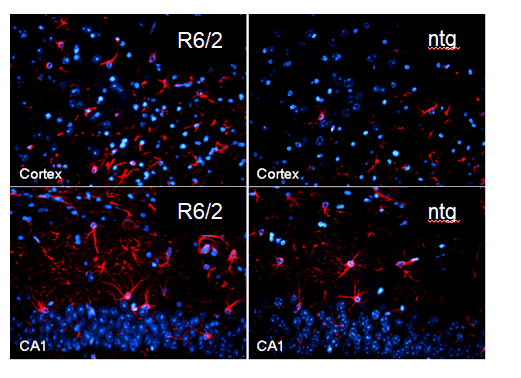R6/2 mice model human Huntington’s disease (HD) by expressing a portion of the human HD gene under human gene promoter elements (1 kb of 5 UTR sequence and exon 1 together with ~120 CAG repeats). Expression of this amino-terminal fragment of the huntingtin protein with its polyglutamine expansion is sufficient to generate the phenotype of human HD.
The most important characteristics of R6/2 mice are:
- HTT aggregates
- Reduced activity
- Motor deficits
- Learning and relearning deficits
- Reduced anxiety
- Neuroinflammation
- Striatal alterations
- Neuronal atrophy
- Mean survival of 100 days
Progressive motor deficits of R6/2 mice start at the age of 6 weeks and can be measured with the RotaRod test. The two choice swim test allows evaluation of cognitive deficits in R6/2 at the age of 10 weeks (Figure 1).

Figure 1 (A): RotaRod performance of R6/2 mice: Motor coordination expressed as time until falling off the rod with progressing age (tg: n = 10; ntg: n = 19); (B) two choice swim test: percentage of wrong choices during 5 training days with 5 trials per day followed by one reversal day with 15 trials (n = 14 per group); two-way ANOVA with Bonferroni`s post hoc test. Mean ± SEM. **p<0.01; ***p<0.001.
Astrocytosis as measure of neuroinflammation in R6/2 mice can be observed in the cortex and hippocampus at the age of 15 weeks (Figure 2).

Figure 2: Astrocytosis in R6/2 mice: R6/2 mice feature increased levels of astrocytosis compared to ntg controls. GFAP (astrocytes, red) plus DAPI (nuclei, blue) in the primary somatosensory cortex and CA1 region of the hippocampus.
QPS Neuropharmacology offers a custom-tailored study design for R6/2 mice, and we are flexible to accommodate your special interests. We are also happy to advise you and propose study designs. R6/2 mice show a relevant HD phenotype at the age of 6 weeks. This grants a remarkable fast processing time of your HD study. Furthermore, non-transgenic littermates are available as control animals needed for proper study design.
We are happy to evaluate the efficacy of your compound in the R6/2 mouse model! The most common readouts are:
- Motor deficits
- Survival
- Learning and Reversal learning deficits
- Neuronal atrophy
- Neuroinflammation
- polyQ HTT quantification
Looking for something else? Please contact us!
